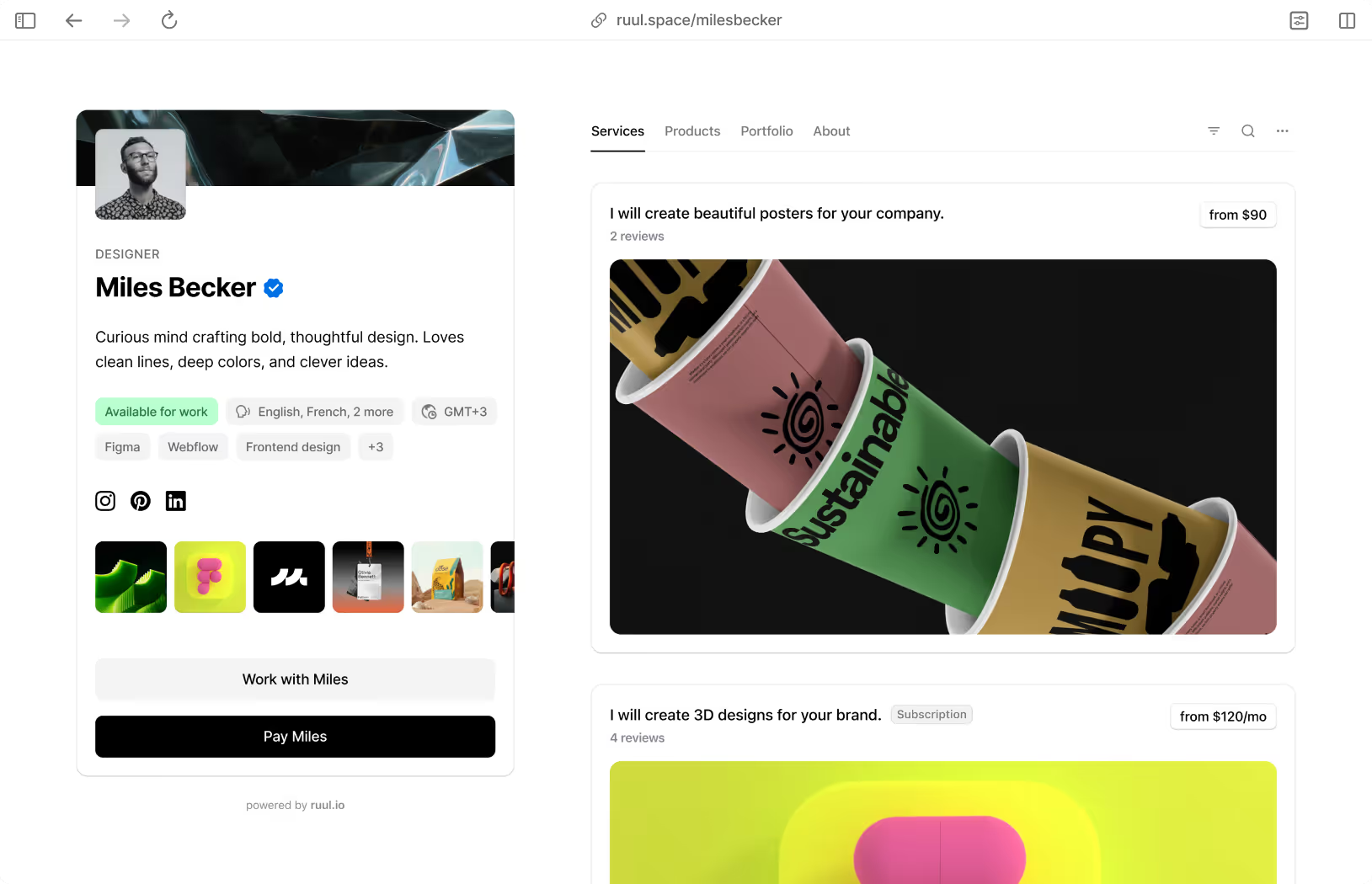Sick of juggling feast‑or‑famine months? Selling subscriptions flattens the roller coaster. Instead of chasing every sale, you earn predictable revenue while customers enjoy uninterrupted value.
This guide walks you through:
- choosing the right subscription model,
- pricing it for profit,
- marketing it with precision, and
- keeping churn near zero.
Additionally, we will discuss tools that automate payments, taxes, and compliance, allowing you to focus on your creative work.
Ready to swap unpredictable gigs for income you can count on?
Let’s discover the world of subscription payment!
Learn the basics: What is a subscription business model?
Instead of one-time sales, a subscription business model builds an ongoing relationship between a business and its customers. Subscribers make recurring payments weekly, monthly, or annually to access a product, service, or content.
That’s great, especially if you’re tired of late payments.
Most subscriptions auto-renew, which means fewer barriers for customers and more predictable revenue for companies.
With Ruul Space, you can simplify the subscription process for your clients. Once you create a service, all the client needs to do is click to “Subscribe Service” button.
See the interface here:
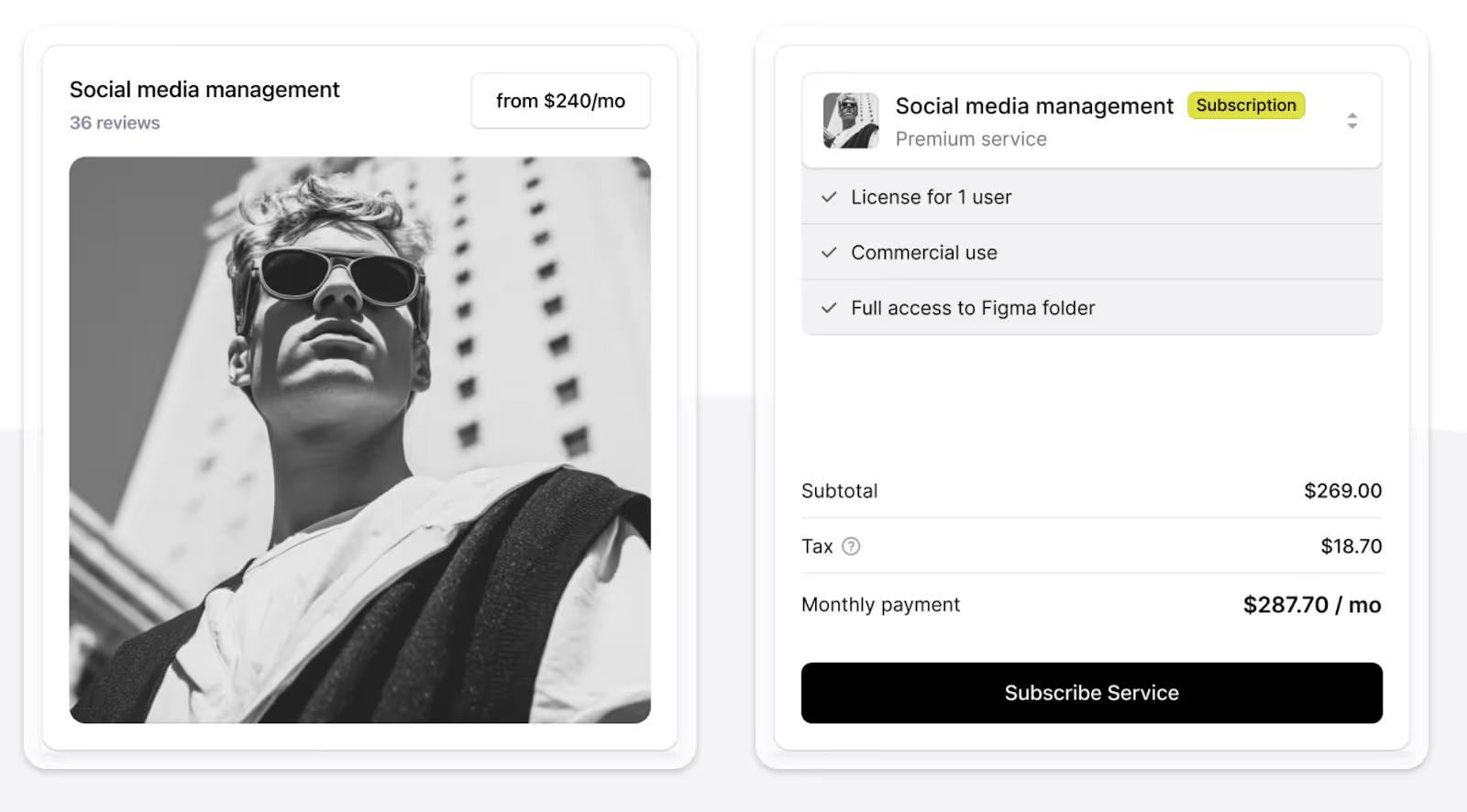
Try Ruul Space now. It’s free to use!
Why a subscription model?
Well, it sounds interesting, but should you go for a subscription model? Let’s talk about the benefits to know.
1- Predictable revenue and better planning: You get long-term projects, and you can plan your schedule more easily because you know what your tasks are for the upcoming month.
2- Easy accounting processes for both sides: Your clients don’t need to pay manually, and you don't need to deal with invoicing every month. Everything, crystal clear for everyone.
3- Deeper client relationships: Subscriptions encourage long-term collaboration, reducing the constant cycle of finding new clients. Great for you. And for the client, working with the same freelancer reduces onboarding time and ensures brand consistency. They love that.
4- Scalability and upselling opportunities: It’s easier to convert your subscribers to layer on higher tiers (extra services, faster delivery, premium support). Plus, clients can adjust tiers (basic, pro, premium) as their needs grow.
Subscription service models: SaaS, Curation, or Access?
Let’s break them down clearly so you can spot the best fit for your skills, your audience, and your business goals.
1- SaaS (Software as a Service)
SaaS is about giving people access to a tool or platform you’ve built, usually for a monthly or annual fee. The customer doesn’t own the software; they just use it online.
Slack, Canva, and Notion are commonly used SaaS products.
Key features:
- Recurring payments: You get steady revenue as long as the customer stays subscribed.
- Cloud-based: The product is accessed online, no installation needed.
- Flexible pricing tiers: Customers can choose plans based on features, usage, or user count.
📌 Bottom line: SaaS is your path from one-on-one to one-to-many. It's the most scalable model, and it's closer than you think.
2- Curation or Package model
The curation model is all about taste and trust. You deliver a carefully selected set of products, resources, or content that fits your audience’s needs or style.
For example, monthly social media management packages, birchboxes (beauty samples tailored to preferences), design asset subscriptions, monthly industry roundups from a consultant.
Key Features:
- Handpicked value: Customers trust your selection more than they want to choose themselves.
- Discovery & delight: Surprises, recommendations, or things they wouldn’t find on their own.
- Personal touch: Makes customers feel seen and understood.
Ruul Space makes it easier to sell your packages (just a click and boom). To try Ruuling out, join the community of over 35,000 freelancers worldwide today.
Your profile can look like that on Ruul Space 👇🏼
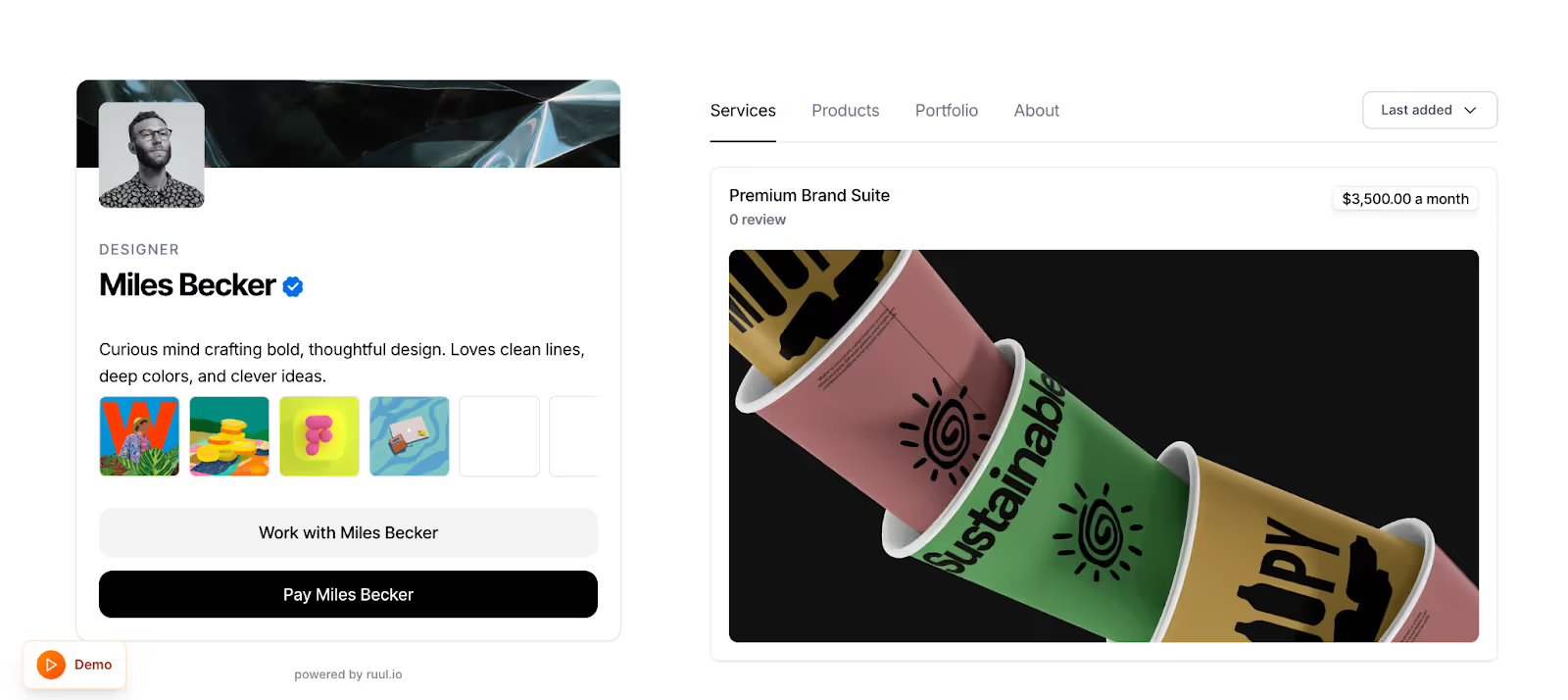
📌 Bottom line: You're the product. Package your judgment, not just your output.
3- Access model
Access models work by offering exclusive perks, private communities, or early access. Things your audience can’t get elsewhere. It’s not just about what you offer, but who gets to be part of it.
Patreon, Substack, and OnlyFans are the platforms you may have heard of. They are made for an access model.
What does it look like for an independent?
A solo business coach offering a paid Slack or Discord mastermind group and a digital marketer who shares practical tips on a paid Substack newsletter are two examples.
Key features:
- Exclusive entry: Behind-the-scenes content, discounts, beta features.
- Community: Shared space for learning, support, or networking.
- Tiers & perks: Offer basic and premium levels with extra benefits.
How to set a pricing strategy for subscriptions
Pricing strategies for freelancers are a reflection of your value and a key driver of growth and retention in the subscription economy.
Here are different options to guide you through pricing your subscription-based products and services:
1- Tiered pricing: Why three options often work best
Tiered pricing means offering two or more plans, each with different features and price points. It helps you serve a wider range of customers, from those with small budgets to those who want the full experience.
Most people tend to choose the middle option. It feels safe, not the cheapest, not the most expensive. This is sometimes called the "Goldilocks effect": not too little, not too much.
It helps to design your middle tier carefully and make it noticeably better than your basic plan, but still affordable. It should feel like the best deal. In my experience, this is the plan most customers pick, especially if they’re unsure.
You don’t need too many options.
Three is usually enough: something simple, something in-between, and something premium.
Here’s what works well with tiered pricing:
- It’s flexible: You give customers a choice that fits their needs.
- It encourages upgrades: As their needs grow, they can move up a tier.
- It shows clear value: Each tier feels like a meaningful step up.
A word of caution: too many options can confuse people. If they pause and think too long, they might not choose at all. Keep your pricing page clear, and show what makes each plan different in plain terms.
See our hourly rate calculator to get some ideas.
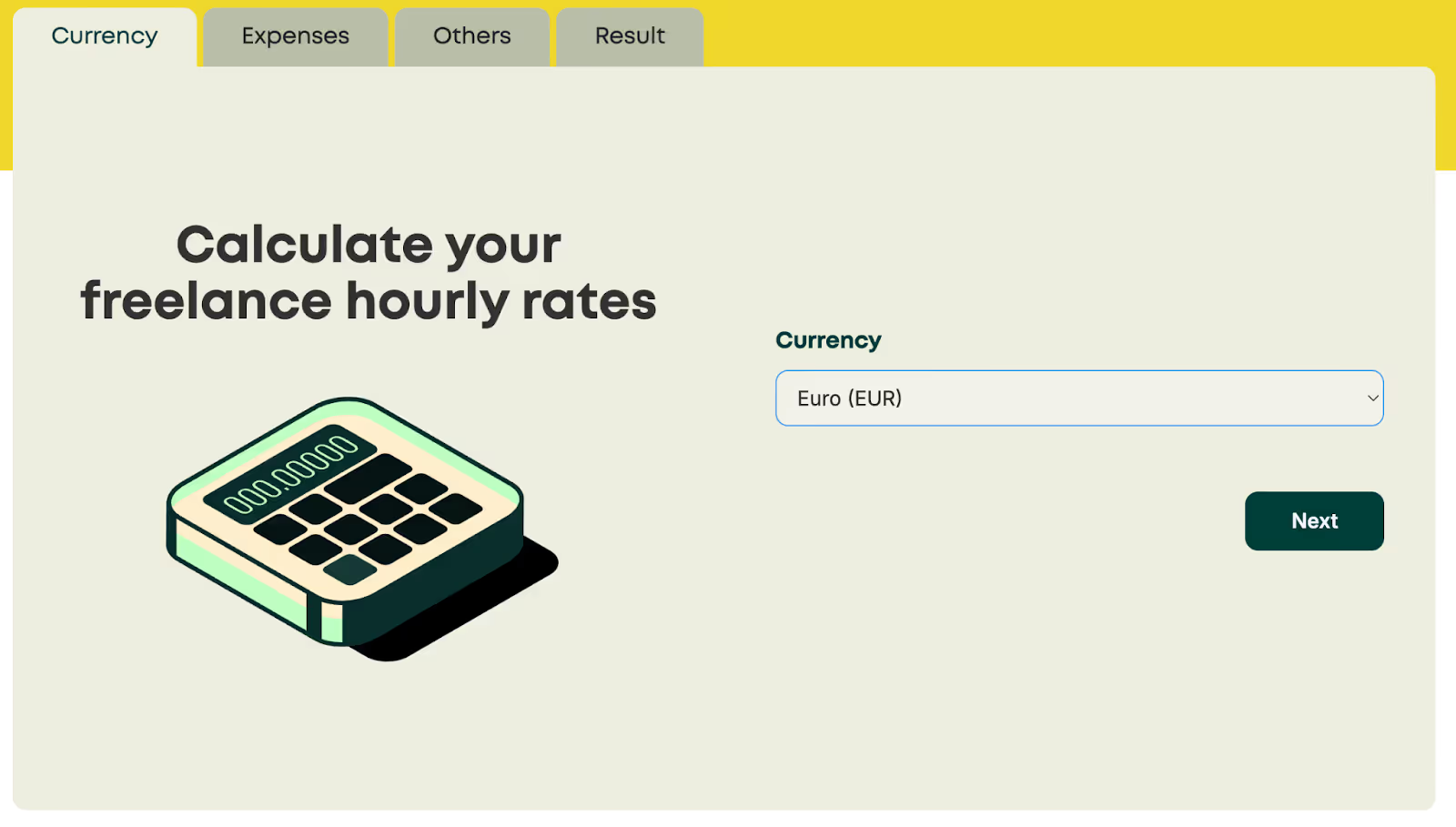
2- Freemium model: Let users try before they buy
The freemium model blends "free" and "premium." Users get access to a basic version of your product for free indefinitely. If they want more advanced features, they pay.
This is different from a free trial, which usually offers full access but for a limited time. Freemium gives users room to explore at their own pace, with the hope that they'll eventually want more.
But here’s the catch: most users never upgrade. The real challenge is turning free users into paying ones.
That’s where observation and timing come in. Instead of just offering a free version and hoping for the best, watch how people use it.
- Do they get stuck?
- Are they using one feature often but ignoring another?
This data tells you where they’re finding value and where they might need a nudge.
You can use things like in-app messages or reminders to show them what they’re missing.
For example, if someone keeps hitting the usage limit of a free feature, that’s a natural moment to offer an upgrade. These nudges don’t need to be aggressive, just helpful and well-timed.
For freelancers and small teams, this means setting up simple tracking and paying attention to patterns. Even a few small insights can make a difference.
3- Usage-based pricing: Pay for what you actually use
In usage-based pricing, your customer’s bill depends on how much of the product or service they actually use. This could be anything from API calls and file storage to the number of invoices they send.
At Ruul, for example, we use a simple version of this: freelancers only pay a flat 5% transaction fee when they issue an invoice. No invoice, no cost. You can try it now.
Also see this invoicing guide.
This model is appealing to users because there's no upfront commitment. But for small businesses or solopreneurs, relying solely on usage-based income can be risky. If your users slow down or leave, your revenue drops instantly.
One workaround is a hybrid model. Think of it as a small monthly fee plus variable usage costs. It gives you a bit more predictability without scaring away users with high upfront pricing.
Another option is to group usage into tiers, like "up to 50 invoices/month" for $X. That way, users still feel in control, but you avoid tiny, fluctuating charges that make budgeting hard for both sides.
If your own expenses also scale with usage (like paying for cloud services or software APIs), it’s worth mapping out your breakeven points before choosing a model.
Whatever you go with, make sure your pricing is easy to understand. Nobody likes surprise bills, especially when they’re just getting started.
Bonus: Psychological pricing: Practical tactics that gently guide decisions
Psychological pricing is also about how you present prices. Subtle changes in the way the numbers look or when they look can affect the way the customer perceives value. I will teach you how to do this.
Practical pricing tactics to try:
- Charm pricing (.99 or .95): Pricing something at $9.99 instead of $10 isn’t just a gimmick, it works because we read prices from left to right. That "9" feels like a deal, even though the difference is just a cent.
- Urgency drivers: Time-limited offers, countdown timers, or even showing limited stock taps into FOMO (fear of missing out). If you've ever bought something just before a sale ended, you’ve felt this in action.
- Value framing: The way you word an offer matters. Saying “Buy one, get one free” often feels more generous than “50% off two”, even though the math is identical.
- Clean price appearance: Dropping the unnecessary decimals (like $12 instead of $12.00) can make prices feel simpler and cheaper. It’s a small edit, but worth testing.
- Flat rate clarity: If your product has multiple moving parts or costs, bundling them into one predictable price helps reduce the buyer’s mental workload. That clarity can be a deciding factor.
- Freemium hook: Offering a basic free plan helps people experience your product before committing. If the upgrade path is clear and the premium value is obvious, many will choose to move up.
- Anchoring effect: The first price a visitor sees sets a mental benchmark. If your most expensive plan is shown first, the mid-tier might suddenly feel more reasonable.
- Highlight what stands out: Using bold labels like “Best Value” or visually isolating a plan can make it more memorable. That’s the Von Restorff effect in action—our brains notice what’s different.
You don’t need to use every tactic at once. Start small.
Test one or two changes: swap out a price structure, add a time-based offer, or play with how you visually highlight your plans. If you're offering tiered pricing, try positioning the plan you want most people to choose in the middle and label it clearly.
Small adjustments to price presentation often outperform big shifts in actual pricing. It’s about making the value you offer easier to see and easier to say yes to.
How to reach and retain subscribers?
Your subscription-based service or product is out. But is it loud (and discoverable)? It should be.
1- Content marketing: Be the person they turn to
Think of content marketing as your long game. The goal? Become a go-to resource for your audience—someone who helps solve their problems, not just sells to them.
Start with these:
- How to guides: Help readers take action. Short and useful beats long and vague.
- Trends and insights: Share what’s happening in your industry and why it matters.
- Free tools and downloads: Simple calculators, checklists, or templates can be game changers.
- Customer stories: Real people > abstract benefits. Let your users do the talking.
When done right, this kind of content builds trust and keeps people engaged. And over time, it makes your subscription feel like a must-have rather than a nice-to-have.
Tip: Content isn't just for getting new customers, it's also a reminder to current ones that their subscription is still worth it.
2- Social media: Show up, listen, connect
If content marketing is your library, social media is your café. It’s where you interact, respond, and learn what your audience actually wants.
What to try:
- Ask questions: Simple polls or Q&As often bring surprising insights. LinkedIn and Instagram Stories are good places for this.
- Behind-the-scenes: Show how you work, what you’re building, or even where you work from. People like to see the sincerity and real-life scenes in the background.
- Short videos: Reels, TikToks, Shorts. These formats travel far when they feel genuine. The other day, I saw that a 1-second Reels had 4.5 million views, it's not a joke, it's real.
Platform focus:
- Instagram: Great for visuals and lifestyle content.
- TikTok: Raw, relatable, and fast-moving.
- YouTube: Ideal if you teach or explain complex topics.
Why it matters: Your subscribers are part of a community. When people feel included and heard, they stick around.
Also, people generally don't want to follow business accounts (unless you are offering something fun). Instead, they want to follow the founders, team members and see their lives.
3- Email marketing & automation: Keep the conversation going
Email is personal. Unlike social media, your emails land where people pay attention, their inbox.
Start simple with automation:
- Welcome email: A warm hello, quick tips, maybe a thank-you gift.
- Reactivation: For quiet subscribers, “Still with us?” goes a long way.
- Product tips: Help users get the most out of what they’ve already paid for.
With email automation, you can maintain consistent, high-touch communication with your growing subscriber base without having to send each email manually.
This allows you to effectively scale your customer relationship management efforts and frees up valuable time for your core business activities.
4- Influencer marketing that actually works
People trust people, not logos. When an influencer really uses your product and doesn’t just hold it up in a selfie, it lands.
Their audience sees it in action and thinks, “Huh, maybe this is worth checking out.”
It’s personal, not polished. The best campaigns feel like a friend giving a recommendation, not a brand trying to sell something. A casual Instagram Story or messy desk setup with your product = ✨ gold.
Content types that convert with influencers
I've seen these formats perform really well for subscriptions:
- Short-form videos (TikTok, Reels, Shorts): Great for showing quick value or humor.
- Unboxings: Still going strong. People love the excitement and raw reaction.
- Mini tutorials: Show them how your product fits into their life.
- “A day in the life” with your product subtly included. Organic is everything.
- UGC-style content: Even if created by an influencer, make it feel user-generated.
Ask influencers what type of content their audience loves. Don’t assume. You might be surprised.
It’s not about follower count. I mean it.
A niche creator with 5K loyal followers can bring you more subscribers than a mega-influencer with a million passive ones.
Look for alignment in values and tone. If you’re playful and they’re super polished, it’s probably not a fit.
Always check engagement (comments, not just likes). Are people actually talking to them?
Choose a MoR platform for subscription sales
If you’re a solo creator, freelancer, or indie SaaS founder, you’ve probably asked yourself:
“How the heck do I handle payments, taxes, and all the legal stuff across countries?”
That’s where a Merchant of Record (MoR) comes in. And honestly? It’s a game-changer.
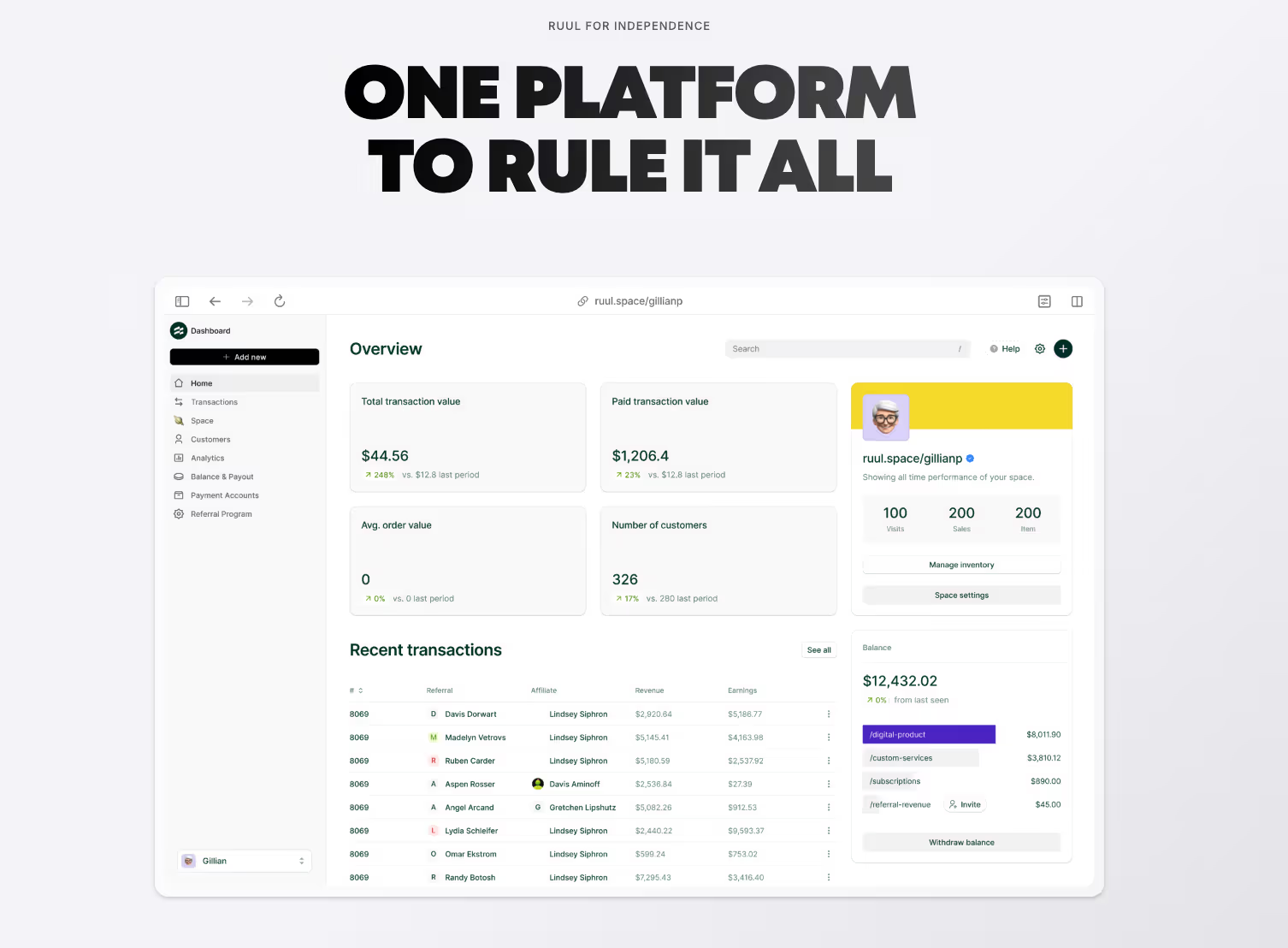
Check out Ruul Space. It’s free to use. Pay nothing until you get your subscribers. Then, we will ask for 5% commission fee. No hidden fees. Sure.
What is a MoR (and why should you care)?
A Merchant of Record is a service that takes care of selling on your behalf. That means when someone buys from you, it’s technically the MoR handling the transaction.
Why does that matter?
Because they deal with all the messy stuff you don’t want to touch:
- Processing payments (yes, including international ones)
- Handling taxes, calculating, filing, and paying them (huge!)
- Managing currency conversions
- Staying compliant with local laws (so you don’t have to learn EU tax code at 2 AM)
- Dealing with chargebacks, refunds, and customer support tied to payments
Basically, they’re like your international operations team without needing to hire anyone.
Top subscription sales platforms (with Merchant of Record support)
1. 🏆Ruul: Built for subscription-based services and software
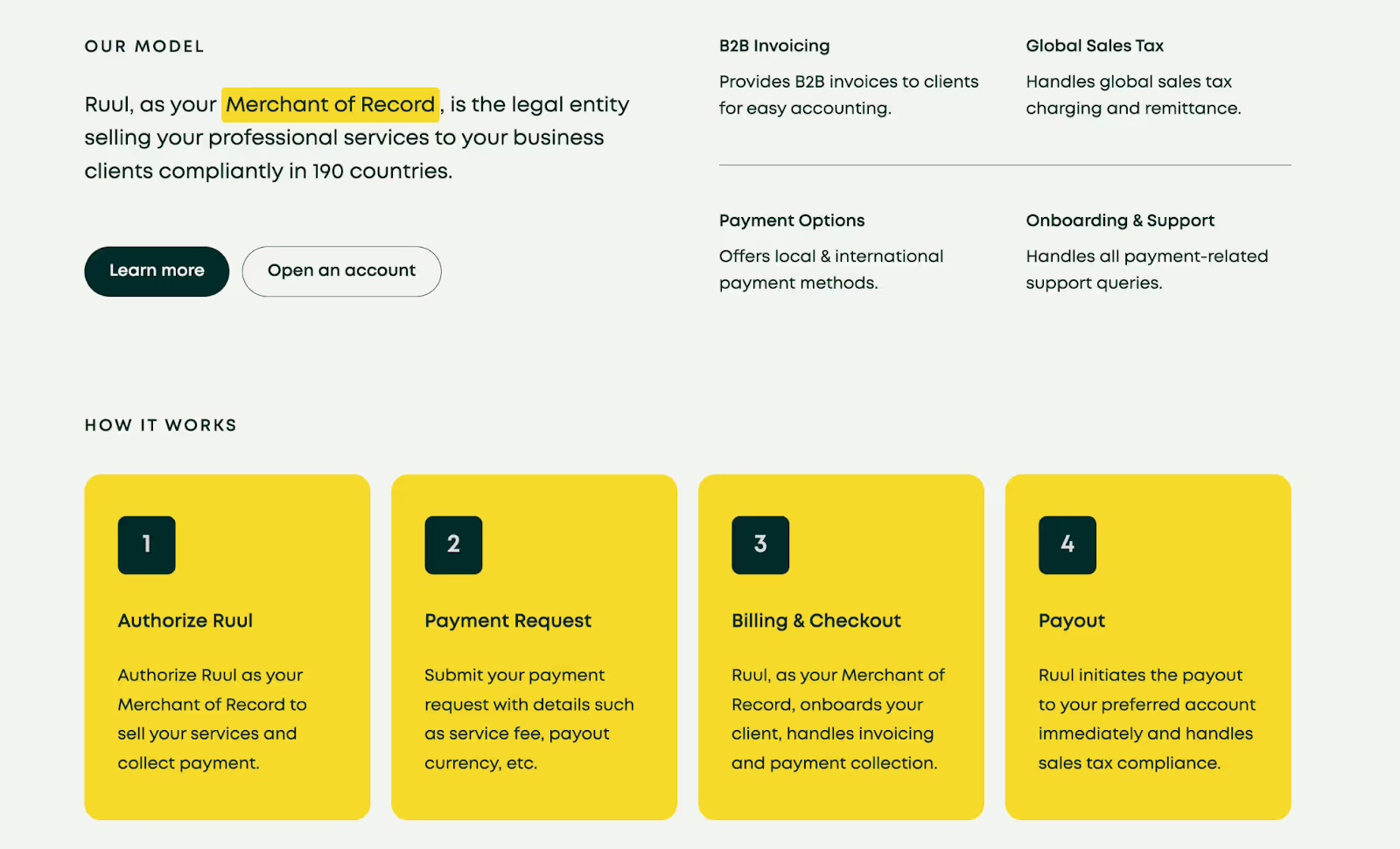
At Ruul, we support both professional services (like freelance work) and digital products (like software or tools).
That means whether you're offering monthly social media management, online classes, or even access to a custom SaaS tool. You can set up recurring billing and let the platform handle the boring stuff.
Here’s what that looks like:
- Create a subscription model for your clients. Great for retainers, long-term collaborations, or fixed monthly packages.
- No chasing payments. Recurring invoices are sent automatically, and payments are collected on schedule.
- Supports both services and software. Whether you’re selling time or tools, it works.
- Set it once, and focus on the work. You don’t have to send reminders or follow up on unpaid invoices.
- Global compliance handled. We deal with sales tax, invoicing, and customer billing support.
- Simple for clients. They don’t need an account to pay; everything is smooth and low-friction.
- Crypto and local currency payments. More ways to get paid, faster.
This setup is especially useful if you work with international clients or offer retainer services. It adds structure to your business and reduces mental load. No awkward payment reminders, no missed invoices, just a clean and automated flow.

An example of use: If your client buys recurring services from you every month, such as “10 blogs” or “monthly social media management”, you can turn this into a subscription with Ruul.
Pricing:
- No monthly subscription fee.
- We only charge 5% fixed commission per transaction.
Start Ruuling the subscriptions now.
2. Paddle

Paddle is built for SaaS companies and software businesses that want an all-in-one solution for global sales, taxes, and subscriptions.
Key features:
- Manages subscriptions, renewals, and dunning
- Full responsibility for global sales tax
- Includes chargeback protection and fraud prevention
- Developer-friendly tools and APIs
Pricing:
- 5% + $0.50 per transaction
- Custom pricing available for high-volume sellers
For solo creators or freelancers, it can feel a bit too heavyweight and technical.
3. Lemon Squeezy
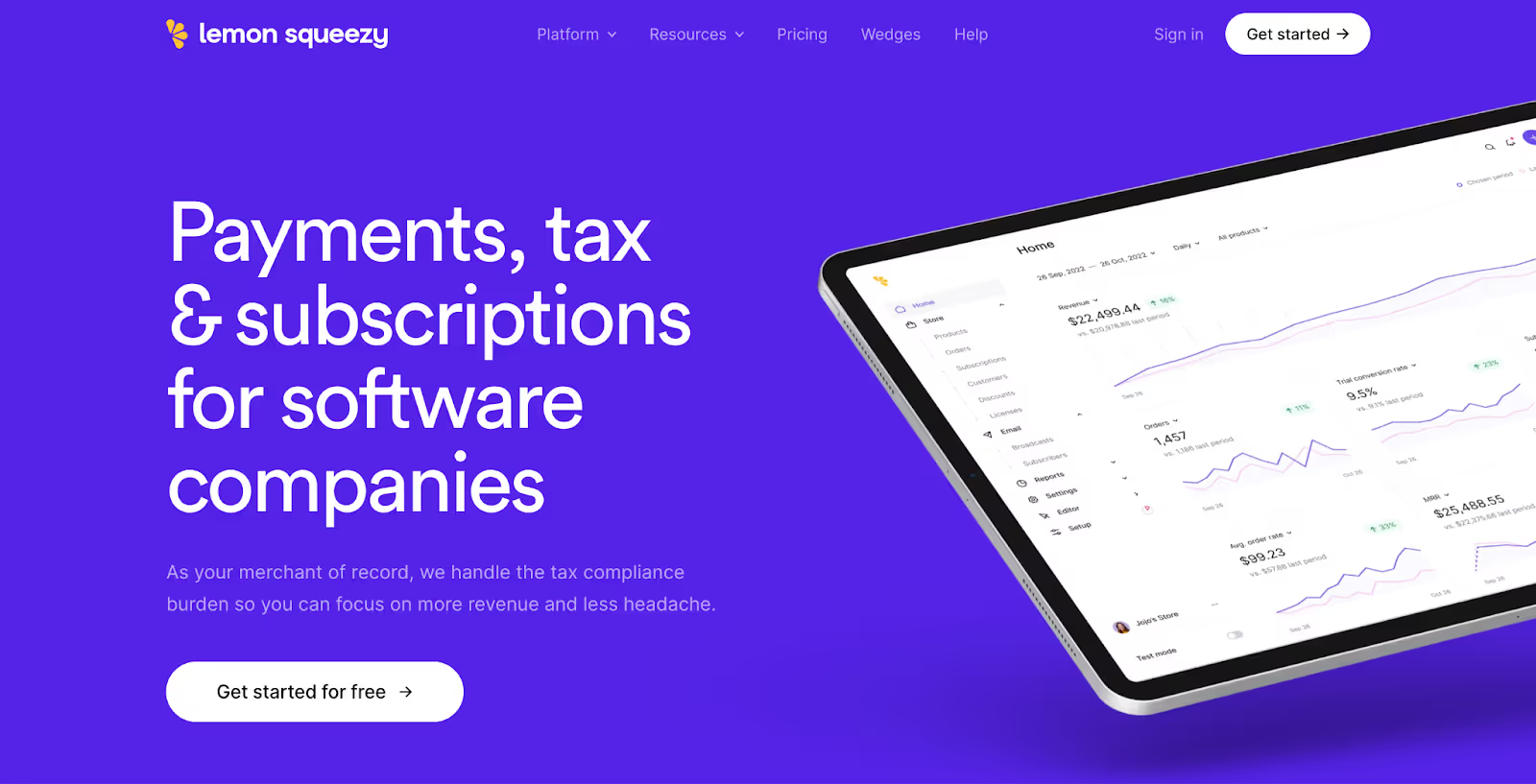
Lemon Squeezy is an e-commerce platform for small businesses and creators selling software, licenses, or digital products.
Key features:
- Supports subscriptions, upgrades, free trials, and discounts
- Built-in VAT and sales tax handling
- License key delivery for software products
- Abandoned cart recovery and analytics tools
Pricing:
- 5% + $0.50 per transaction
- No monthly fees, but additional banking fees may apply
Just be prepared for slightly higher transaction costs, especially in Europe, and don’t expect much help with marketing. It’s all DIY on that end.
4. Gumroad
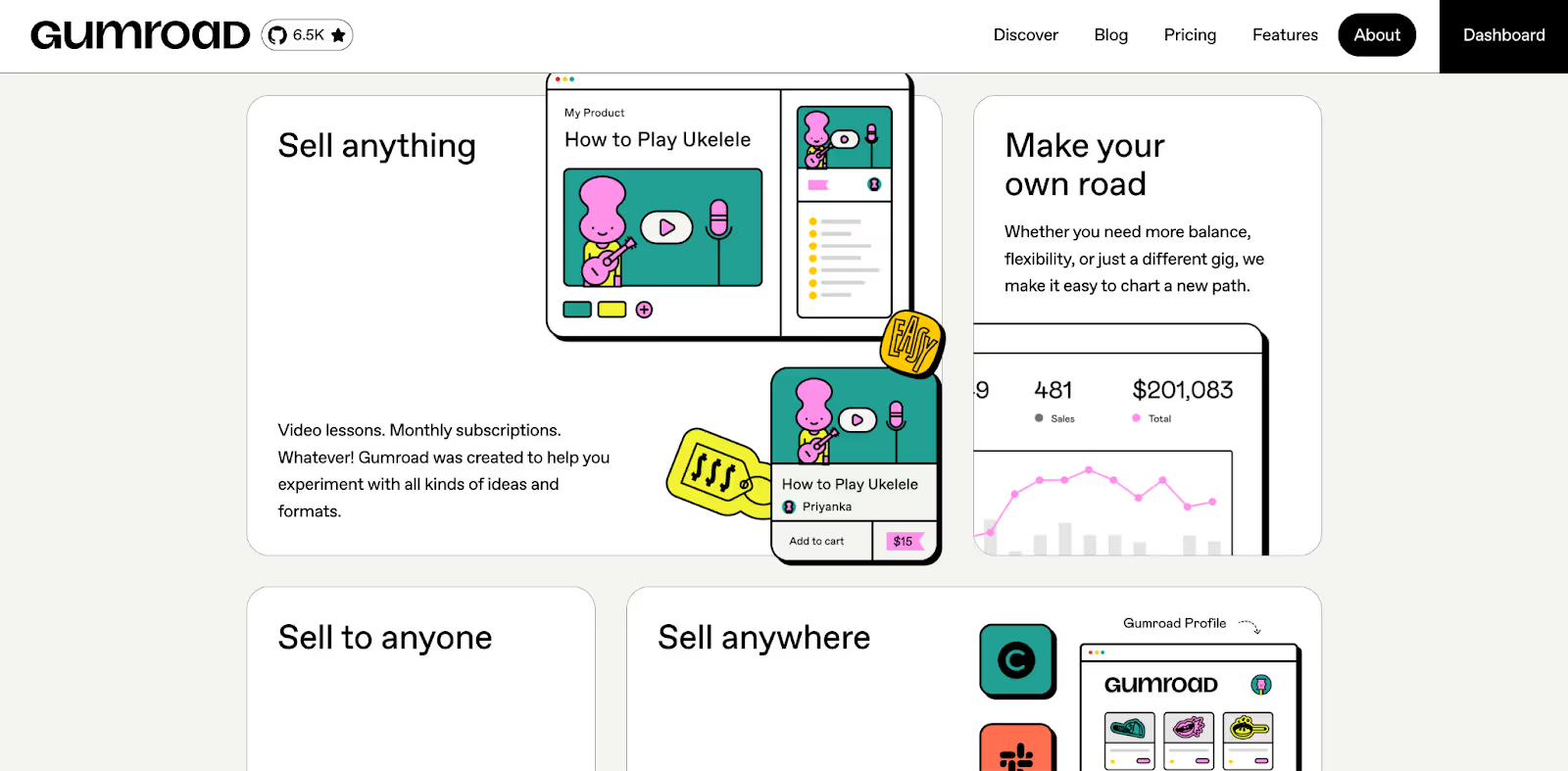
Gumroad is a simple platform for selling digital content, ideal for artists, writers, and indie creators starting out.
Key features:
- Supports unlimited digital products and memberships
- Basic analytics and customer management
- Customizable checkout and domains
- MoR with partial tax handling
Pricing:
- No monthly plan.
- Free plan: 10% + processing fees
Super easy to set up and use, but the 10% fee on the free plan adds up quickly. Good for testing the waters, but as your sales grow or you want more control, you’ll likely outgrow it.
Mastering customer retention (without making it complicated)
So here’s the thing: keeping your customers around is way more powerful than constantly chasing new ones. Retention brings in stable revenue, loyal fans, and a ton of peace of mind. Let’s break down how to make that happen, starting with the very first interaction.
1- Make onboarding a wow moment
Think of onboarding as your first date with a customer. It sets the tone.
- Start fast. Don’t make them wait to use what they paid for. If it’s content, let them read/watch now. No delays.
- Welcome with intent. A little gesture (like a gift or a warm email) before they even pay shows you’re in this for the long run.
- Ease them in. Use emails, product tours, or even memes—whatever fits your brand to guide them through using your product.
- Give options. Some people love step-by-steps; others want to skip ahead. Let them.
Send one solid welcome email. Thank them, show them where to start, and offer help. Bonus points if it doesn’t feel like it was written by a robot.
What’s worked for me: breaking onboarding into small “aha” wins. Like, “Set this up in 2 minutes.” or “Try this now and save time later.” It keeps people moving without overwhelm.
2- Use a CRM. But make it work for you
You don’t need to get lost in dashboards and reports. But having some kind of system to track your customer relationships is huge.
Here’s what a simple CRM setup can do:
- Help you spot who's about to churn (e.g., haven’t logged in for 2 weeks).
- Automate some messages: “Hey, noticed you haven’t used your plan. Want a quick demo?”
- Give you a 360° view of your customer: What they like, what they ignore, and what bugs them.
The right nudge at the right moment keeps people around.
3- Listen like you mean it
Most brands collect feedback and then… do nothing. Don’t be that brand.
Here’s how to turn feedback into retention gold:
- Quick polls in newsletters: “What’s your biggest challenge right now?”
- Preference pages: Let people choose how often they hear from you and what about.
- Social media check-ins: Ask questions. Run topic votes. People love having a say.
- Follow up on feedback: “Hey, you said X wasn’t working. Here’s what we did.”
Honestly, feedback is your shortcut. Your customers will literally tell you how to keep them… if you ask the right way.
4. Fighting churn (before it starts)
Every subscription biz deals with cancellations. The trick? Stay ahead of them.
- Ask why people leave. A 1-click “Sorry to see you go. Mind telling us why?” goes a long way.
- Make your value clear. If your product saves people time, money, or effort, say it often and clearly.
- Be upfront. People cancel less when pricing and renewals are crystal clear from the beginning.
- Use your content. Emails, blogs, even memes—anything that reminds people why they signed up.
One small but powerful tip: Reward loyalty. A surprise gift at month 6, a “thank you” email at renewal time… these things stick.
Finally, if you're just starting, pick one area, maybe onboarding or feedback, and do it really well. You’ll start seeing results way faster than trying to fix everything at once.
How Ruul helps you sell subscriptions (Without losing your mind)
Selling subscriptions sounds easy. Until you try to deal with payment systems, tax laws, and chasing clients who “forgot” to pay.
That’s where Ruul steps in.
Here’s what it really does for you:
→ Handles all the messy stuff: Taxes, invoicing, compliance, payouts. Ruul acts as a Merchant of Record (MoR), so you're not buried in admin.
→ Lets you focus on building, not billing: Whether you're a freelance designer or running a micro SaaS, Ruul helps you sell subscriptions without learning international finance.
→ Global reach, no drama: Sell in 190+ countries, accept payments in 140 currencies (yep, including crypto). I didn’t even know that many currencies existed.
→ Predictable pricing: Ruul takes a 5% commission per transaction.
Ready to take control? Sign up for Ruul and start selling your subscriptions your way. Over 100,000 independents have already made the switch.
FAQ
1. How do you sell a subscription?
Sell subscriptions by highlighting predictable value, unique benefits, and exclusive access. Offer tiered pricing and automate the sales process using a Merchant of Record.
2. How to market a subscription service?
Market your service through targeted content, active social media engagement, and automated email campaigns. Leverage influencer partnerships that genuinely showcase your product's ongoing value.
3. How to make money from subscriptions?
Make money by prioritizing high customer retention and encouraging upgrades to premium tiers. Consistently deliver and communicate the perceived value to ensure recurring payments.
4. Is a subscription model profitable?
Yes, a subscription model is often highly profitable. It offers predictable recurring revenue, increases customer lifetime value, and fosters stronger, more stable customer loyalty over time.








